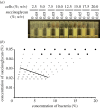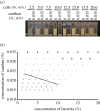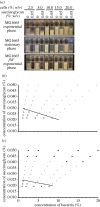Aggregation by depletion attraction in cultures of bacteria producing exopolysaccharide
- PMID: 22896568
- PMCID: PMC3481587
- DOI: 10.1098/rsif.2012.0498
Aggregation by depletion attraction in cultures of bacteria producing exopolysaccharide
Abstract
In bacteria, the production of exopolysaccharides--polysaccharides secreted by the cells into their growth medium--is integral to the formation of aggregates and biofilms. These exopolysaccharides often form part of a matrix that holds the cells together. Investigating the bacterium Sinorhizobium meliloti, we found that a mutant that overproduces the exopolysaccharide succinoglycan showed enhanced aggregation, resulting in phase separation of the cultures. However, the aggregates did not appear to be covered in polysaccharides. Succinoglycan purified from cultures was applied to different concentrations of cells, and observation of the phase behaviour showed that the limiting polymer concentration for aggregation and phase separation to occur decreased with increasing cell concentration, suggesting a 'crowding mechanism' was occurring. We suggest that, as found in colloidal dispersions, the presence of a non-adsorbing polymer in the form of the exopolysaccharide succinoglycan drives aggregation of S. meliloti by depletion attraction. This force leads to self-organization of the bacteria into small clusters of laterally aligned cells, and, furthermore, leads to aggregates clustering into biofilm-like structures on a surface.
Figures








Similar articles
-
Important Late-Stage Symbiotic Role of the Sinorhizobium meliloti Exopolysaccharide Succinoglycan.J Bacteriol. 2018 Jun 11;200(13):e00665-17. doi: 10.1128/JB.00665-17. Print 2018 Jul 1. J Bacteriol. 2018. PMID: 29632097 Free PMC article.
-
The low-molecular-weight fraction of exopolysaccharide II from Sinorhizobium meliloti is a crucial determinant of biofilm formation.J Bacteriol. 2009 Dec;191(23):7216-24. doi: 10.1128/JB.01063-09. Epub 2009 Sep 25. J Bacteriol. 2009. PMID: 19783627 Free PMC article.
-
Novel Genes and Regulators That Influence Production of Cell Surface Exopolysaccharides in Sinorhizobium meliloti.J Bacteriol. 2018 Jan 10;200(3):e00501-17. doi: 10.1128/JB.00501-17. Print 2018 Feb 1. J Bacteriol. 2018. PMID: 29158240 Free PMC article.
-
Rhizobium meliloti exopolysaccharides: genetic analyses and symbiotic importance.Biochem Soc Trans. 1991 Aug;19(3):636-41. doi: 10.1042/bst0190636. Biochem Soc Trans. 1991. PMID: 1783190 Review.
-
Regulation of succinoglycan and galactoglucan biosynthesis in Sinorhizobium meliloti.J Mol Microbiol Biotechnol. 2002 May;4(3):187-90. J Mol Microbiol Biotechnol. 2002. PMID: 11931545 Review.
Cited by
-
Resistance of Dickeya solani strain IPO 2222 to lytic bacteriophage ΦD5 results in fitness tradeoffs for the bacterium during infection.Sci Rep. 2022 Jun 24;12(1):10725. doi: 10.1038/s41598-022-14956-7. Sci Rep. 2022. PMID: 35750797 Free PMC article.
-
Sporulation Strategies and Potential Role of the Exosporium in Survival and Persistence of Clostridium botulinum.Int J Mol Sci. 2022 Jan 11;23(2):754. doi: 10.3390/ijms23020754. Int J Mol Sci. 2022. PMID: 35054941 Free PMC article.
-
Mechanically-driven phase separation in a growing bacterial colony.Proc Natl Acad Sci U S A. 2015 Apr 28;112(17):E2166-73. doi: 10.1073/pnas.1504948112. Epub 2015 Apr 13. Proc Natl Acad Sci U S A. 2015. PMID: 25870260 Free PMC article.
-
The role of filamentous matrix molecules in shaping the architecture and emergent properties of bacterial biofilms.Biochem J. 2024 Feb 21;481(4):245-263. doi: 10.1042/BCJ20210301. Biochem J. 2024. PMID: 38358118 Free PMC article. Review.
-
Two genomic regions encoding exopolysaccharide production systems have complementary functions in B. cereus multicellularity and host interaction.Sci Rep. 2020 Jan 22;10(1):1000. doi: 10.1038/s41598-020-57970-3. Sci Rep. 2020. PMID: 31969664 Free PMC article.
References
-
- Deinema M. H., Zevenhuizen L. P. 1971. Formation of cellulose fibrils by gram-negative bacteria and their role in bacterial flocculation. Arch. Mikrobiol. 78, 42–51 10.1007/BF00409087 (doi:10.1007/BF00409087) - DOI - DOI - PubMed
Publication types
MeSH terms
Substances
LinkOut - more resources
Full Text Sources
Other Literature Sources

